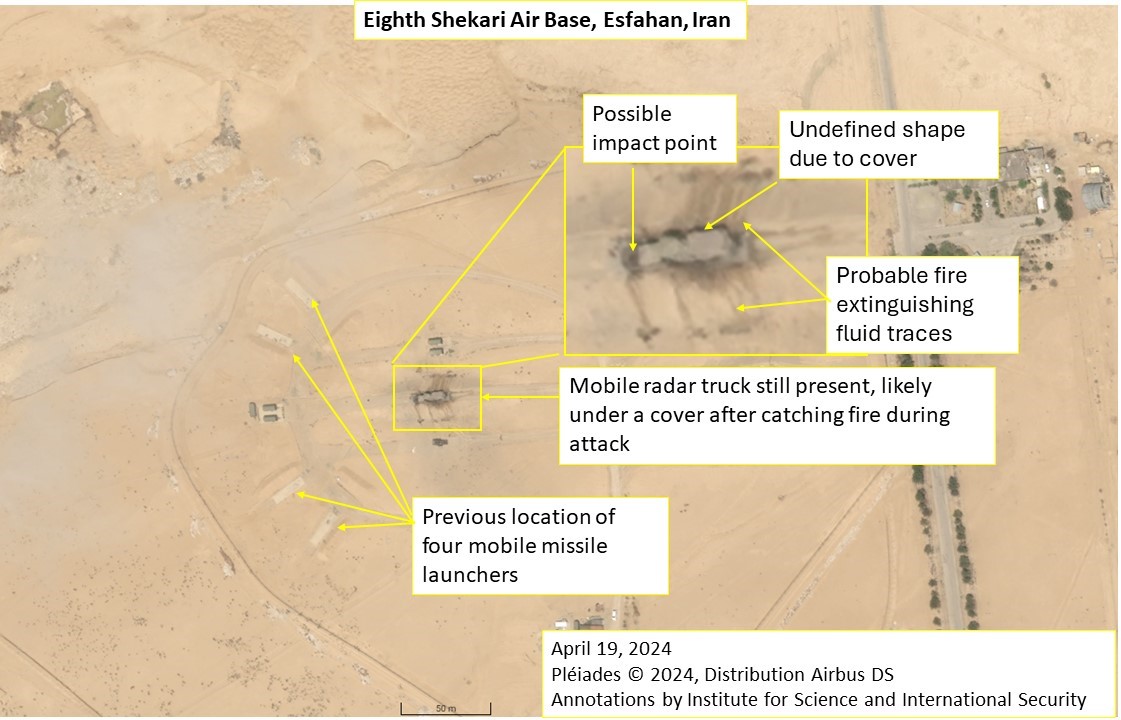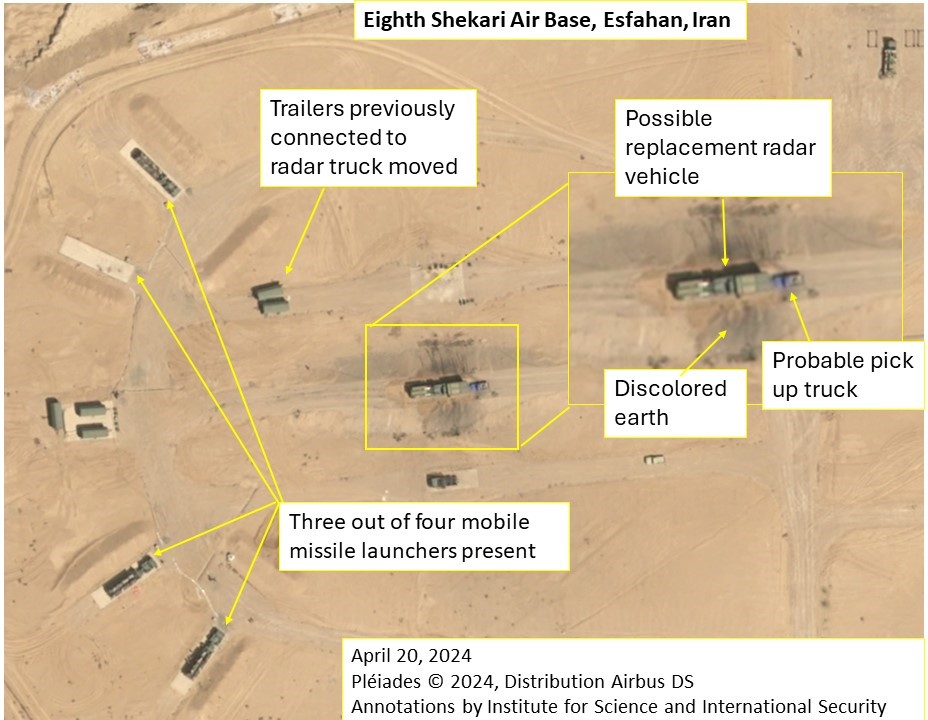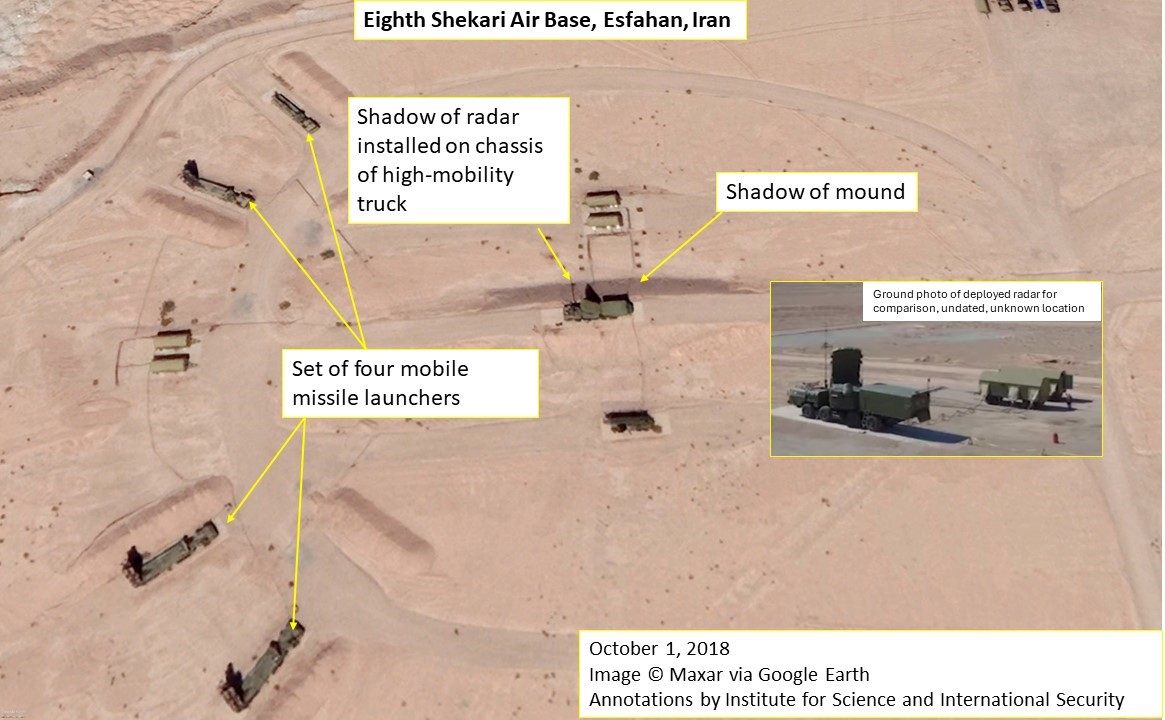The Institute acquired high-resolution Airbus Pleiades Neo satellite images of Iran's Eighth Shekari Air Base taken shortly after the reported Israeli attack on the S-300 missile defense system deployed at the base. Figure 1 shows an April 19 image showing the damage to a S-300 mobile radar, deployed in a central position to the missile launchers, elevated on a mound. The attack shows the capability of Israeli stand-off weapons to target deep inside Iran, evading detection and air defenses, leaving Iran's nuclear and military facilities more vulnerable to attack.
Figure 1. Damage from the attack on Iran's S-300 missile defense system deployed near Esfahan. The mobile radar was visibly damaged and likely caught fire during the attack.
The Attack
Israel reportedly struck inside Iran, near the city of Esfahan, early on Friday morning, April 19, 2024, in response to a large-scale attack on Israel by Iran over the previous weekend. Iranian media originally reported that three small drones were downed with little to no damage. However, subsequent reporting by The New York Times indicates that Israel fired multiple missiles from outside Iran, and Iran was unable to detect or shoot them down. [1] One missile reportedly struck its target, while a second detonated midair. An Israeli official announced that the second missile was deliberately destroyed by the Israeli Air Force after the first successfully hit the target. [2] Israeli officials stated that quadcopter drones were also used to confuse Iranian air defenses.
According to The New York Times, Israeli officials stated that, "an antiaircraft battery in a strategically important part of central Iran" was hit by a missile.[3] Iranian officials also evidently privately admitted to The New York Times that an S-300 anti-aircraft system, stationed at a military air base near Esfahan, was damaged in the strike.
The Eighth Shekari Air Base in northwest Esfahan is the only one in the area publicly known to host this type of Russian-supplied anti-aircraft system; Wikimapia published a geotag for it labeled as C-300 six years ago ("C" in Cyrillic is transliterated to "S"),[4] and it can be seen in Google Earth imagery starting in 2017. Post-attack satellite imagery analyzed by The New York Times reportedly showed damage to the S-300 system at the Eighth Shekari Air Base in Esfahan, stating that, the attack "damaged or destroyed the 'flap-lid' radar, which is used in S-300 air defense systems to track incoming targets."[5] However, The New York Times did not publish the actual imagery. Iran International released a comparison of two undated before and after photos of the missile defense system at the air base, and highlights an area that allegedly shows damage to the "central part of the air defense system."[6] Similar to a Planet Labs image dated to April 22, 2024, published by the Associated Press, it appears to show burn marks around the mobile radar, but the relatively low resolution makes it otherwise hard to detect specific damage. [7]
On Wikimapia, the radar deployed at the site is described as a 30N6E2 Tomb Stone radar, commonly part of the Russian S-300 PMU2 missile defense system. [8] The radar is installed on the chassis of a high mobility truck, consistent with what is reported by The New York Times, and visible in images predating the attack, where the resolution is sufficient to make out the truck and the radar.
Airbus Imagery Showing Attack
The Institute acquired two high-resolution Airbus satellite images of the Eighth Shekari Air Base taken shortly after the attack, dated April 19 and 20, 2024, taken around 11 AM local time in Iran. The images in Figure 2 show the location for four missile launchers and a mobile radar, deployed in a central position to the launchers, elevated on a mound.
The post-attack images show that the radar was clearly damaged, but the extent is unclear. The April 19th image appears to show that the radar vehicle was hit at the end carrying the radar, and likely caught fire. The visible tracks on the raised berm on both sides of the radar vehicle indicate that fire suppression involving extinguishing fluids were applied by firefighting equipment, and the fluids ran down the raised berm to the base and collected there on both sides of the berm.
Post-fire, some type of covering appears to have been placed on the mobile radar, resulting in the undefined shape of the vehicle. A day later on April 20, 2024, a new vehicle appears on the top of the elevated berm; a possible replacement radar vehicle, but it does not appear to be the same type as the one that was apparently damaged. There is also a blue pickup truck directly behind the larger possible replacement radar vehicle.
The four missile launchers were evacuated by the time the image was taken on April 19, with three later returned on the 20th.
For comparison, Figure 3 shows the missile defense system years prior, on October 1, 2018.
Figure 2. Two images taken shortly after Israel's attack on the missile defense system at Eighth Shekari Air Base: An Airbus Pleiades Neo image taken April 19, 2024 (top) and April 20, 2024 (bottom).
Figure 3. The S-300 missile defense system deployed at Eighth Shekari Air Base in 2018. Inset: Undated, Iranian state TV (https://www.youtube.com/watch?v=emu6pm3-Tls)
Significance of the Attack
The S-300 system is reportedly a key part of the air defenses for both the Esfahan and Natanz nuclear sites. [9] The Islamic regime received the S-300 air defense system in 2016 after 10 years of renegotiating an initial contract. [10] The nuclear complex in Esfahan is only about 22 kilometers (km) south from the air base and the Natanz gas centrifuge enrichment plant is about 105 km north of it. The Natanz site is well known as hosting the majority of Iran's gas centrifuges, including about 6,300 advanced centrifuges, [11] in addition to centrifuge manufacturing capabilities. A portion of Iran's most dangerous uranium stockpile, its 60 percent enriched uranium stock, is produced in the above-ground Pilot Fuel Enrichment Plant (PFEP) at Natanz. The Esfahan site is known for hosting a large uranium conversion facility and a zirconium production plant, as well as a small tunnel complex under a nearby mountain. In recent years, the Esfahan site has gained importance in Iran's nuclear program as Iran has developed sensitive uranium metal production capabilities and has chosen to store a large portion of its higher enriched uranium stocks here, in particular a significant fraction of its 60 percent highly enriched uranium stock and its near 20 percent enriched uranium stock. Esfahan also houses centrifuge production capabilities, but the exact location is unknown publicly.
The Fordow enrichment plant, Iran's second location for gas centrifuge uranium enrichment, is about 250 km away. Reportedly, Iran deployed an S-300 defense system at Fordow in 2016, but a commander of Iran's air defense stated at the time that that the S-300 "is a mobile system that should be relocated often." [12]
Official statements released by Iran uniformly chose to downplay the strike and mislead the Iranian public, fearful of escalation and of showing its public and its allies its inability to thwart an Israeli attack on one of Iran's most important military facilities in the heart of the country. In his press conference on April 22nd, the Islamic Republic's Foreign Ministry spokesman, Naser Kanaani, reiterated the point that, "Iran's defense system operated properly, the attacker did not reach their objectives, and the incident did not hold any militarily significance." [13]
An attack on the S-300 defense system inevitably would leave the Esfahan and Natanz nuclear complexes vulnerable to attack. Coupled with Iran's failure of its over 300 missiles and drones to destroy their targets in Israel, this attack sent a strong signal to Iran of its vulnerability to Israeli strikes and its relative inability to reciprocate.
1. Farnaz Fassihi and Ronen Bergman, "Israeli Weapon Damaged Iranian Air Defense Without Being Detected, Officials Say," The New York Times, April 21, 2024, https://www.nytimes.com/live/2024/04/20/world/israel-iran-gaza-war-news. [↩]
2. Ronen Bergman and Patrick Kingsley, "Israel Planned Bigger Attack on Iran, But Scaled It Back to Avoid War," The New York Times, April 22, 2024, https://www.nytimes.com/2024/04/22/world/middleeast/israel-iran-war-strike.html. [↩]
3. "Israel Planned Bigger Attack on Iran, but Scaled It Back to Avoid War." [↩]
4. "C-300," Wikimapia geotag, https://wikimapia.org/#lang=en&lat=32.780492&lon=51.818776&z=16&m=w&show=/38399122/30N6E-E1-TOMBSTONE-X-BAND-ENGAGEMENT-RADAR&search=C-300. [↩]
5. Christoph Koettl and Christiaan Triebert, "Satellite imagery shows that a precision attack damaged an air defense system at an Iranian base," The New York Times, April 19, 2024,https://www.nytimes.com/live/2024/04/18/world/israel-iran-gaza-war-news. [↩]
6. "Iran's Air Defense System Hit, New Satellite Image Shows,"Iran International, April 22, 2024,https://www.iranintl.com/en/202404211475. [↩]
7. Jon Gambrell, "Satellite photos suggest Iran air defense radar struck in Isfahan during apparent Israeli attack," Associated Press, April 22, 2024, https://apnews.com/article/iran-israel-s300-radar-hit-isfahan-attack-ce6719d3df8ebf5af08b035427ee215c#:~:text=After%20Iran%20reached%20its%202015,variant%20of%20the%20S%2D300. [↩]
8. "30N6E2 Tomb Stone Illumination and guidance radar for SA-20 Gargoyle," Armyrecognition.com, April 20, 2024, https://armyrecognition.com/russia_russian_missile_system_vehicle_uk/30n6e2_tomb_stone_illumination_guidance_radar_sa-20_gargoyle_technical_data_sheet_specifications_uk.html. [↩]
9. Ronen Bergman and Patrick Kingsley, "Israel Planned Bigger Attack on Iran, but Scaled It Back to Avoid War," The New York Times, April 22, 2024, https://www.nytimes.com/2024/04/22/world/middleeast/israel-iran-war-strike.html?smid=nytcore-ios-share&referringSource=articleShare. [↩]
10. "Iran tests highly-sophisticated Russian air defense system," Fox News, March 4, 2017, https://www.foxnews.com/world/iran-tests-highly-sophisticated-russian-air-defense-system. [↩]
11. David Albright, Sarah Burkhard, Spencer Faragasso, and Andrea Stricker, "Analysis of IAEA Iran Verification and Monitoring Report - February 2024," Institute for Science and International Security, March 4, 2024,https://isis-online.org/isis-reports/detail/analysis-of-iaea-iran-verification-and-monitoring-report-february-2024. [↩]
12. "Iran Deploys Air Defense System Around Fordo Nuclear Site," Associated Press, August 29, 2016, https://www.reuters.com/article/idUSKCN11415Z/. [↩]
13. "A report of the Foreign Ministry spokesman's press conference," Associated Press, April 22 2024, https://apnews.com/article/iran-israel-s300-radar-hit-isfahan-attack-ce6719d3df8ebf5af08b035427ee215c#:~:text=After%20Iran%20reached%20its%202015,variant%20of%20the%20S%2D300. [↩]









